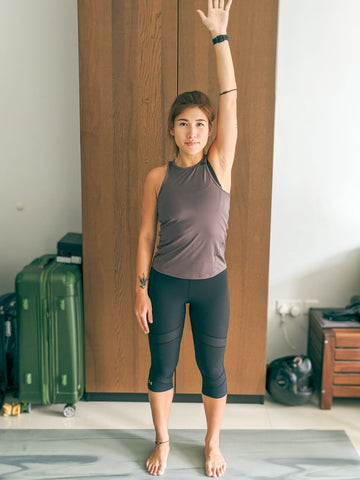By Rynette Tan, Babywearing Consultant & Louise Yow, Principal Physiotherapist at Phoenix Rehab
--
For marathon runners, training helps to keep you in shape and prepares the body to take on the task of running long distance. Similarly, babywearing can be viewed as a sport that you can prepare and train your muscles for, to take on the extra load of carrying your child. It is very much like strength and endurance training.
As the child grows in size and weight, there will be more demands on the person’s body to carry a heavier load.
Here are 3 exercises that you can do to build up more strength to be able to carry your child for longer.
1. Half squats
Half squats help to train up your thigh and buttock muscles. These muscles help to take on the extra weight of the child as well as allow you to be able to carry the extra weight to walk around.
How to do the exercise:
- In standing position, stand with your feet shoulder-width apart and toes pointing forward
- You can hold onto the kitchen sink or put your hands on your hip
- Imagine you are going to sit down onto a chair, sit your bottom back, bend at the hips and stick your buttocks backwards
- When you look down at your toes, you should see and ensure your knees do not go past your toes. Also ensure that the weight is on your heels
- Make sure your back is straight and that you are looking straight ahead. You should not be rounding your shoulders forward. Also take care not to round forward through your mid and upper back
- Return to standing position.



When we talk about core muscles it usually refers to muscles that support the trunk to give us a stable base as we move our limbs to undertake a task. With babywearing, a lot of the weight in undertaken by the caregiver’s trunk/back/spine. Having a stronger core will allow the caregiver to take on the extra weight of the child, but also to support the body/trunk as the caregiver babywear and carry out their task
How to do the exercise:
- Standing relaxed, be aware what your posture is like in this standing position. Now, gently tighten your stomach muscles by imagining your pants are tight and you are trying to pull the zip up.
- Hold the muscles tight while continuing to breathe in and out.
- Holding the tummy muscle in, lift up your right hand. Bring your left hand up while bringing your right hand down to the side of your body. Then bring your right hand up while bringing your left hand down
- Continue to alternate lifting up your hand and finish 5 sets. Ensure your tummy muscles are activated throughout
- Increase the number of sets done as you get stronger



3. Shoulder strengthening
As mentioned in the article on common pains in babywearing, shoulder pain is commonly mentioned in babywearing. This is due to the weight of carrying the child especially in front carry, that tends to bring the shoulder into forward flexion, leading to rounded shoulders. The muscles in front of the shoulder will tend to be tighter and the shoulder blade muscles will tend to weaken over time. By strengthening the shoulder muscles and ensuring the carrier is fitted well, will help to prevent shoulder pain over time
How to do the exercise:
- Looking at the mirror, ensure the shoulders are relaxed, elbow bent to 90degrees, arm kept by the side of the body
- Visualise that you have a ball that is placed at the middle of your upper back, in between the 2 shoulder blades
- Pull your elbow/arm back as your squeeze the shoulder blades together to squeeze the “ball”
- Hold and count to 5 before letting go
- Repeat 5-10 times
- Once you are comfortable with this exercise standing straight up, you can try adding squats to challenge yourself (like in the pictures below)!



In general, maintaining a healthy lifestyle, as well as having a properly fitted carrier can help to ensure unnecessary strains while babywearing.
* Note: Exercises can be done with or without baby in a carrier. For beginners, start off without baby and slowly progress to trying with baby in an ergonomic buckled carrier, wrap or meh dai, with baby in front (inward facing) carry.
Special thanks to Victoria Lim (@thepinksoldier) - awesome mummy and fabulous personal trainer - for modelling for us!

